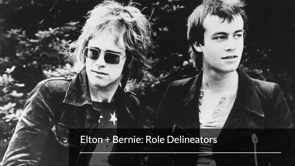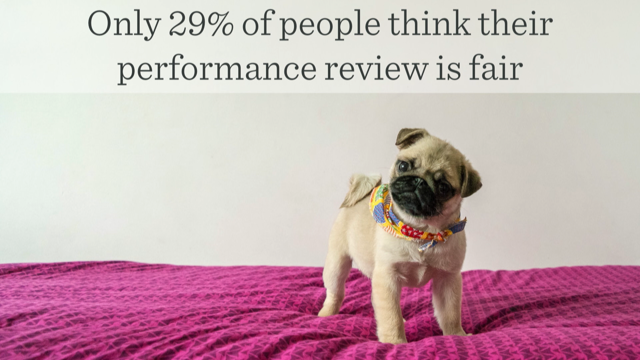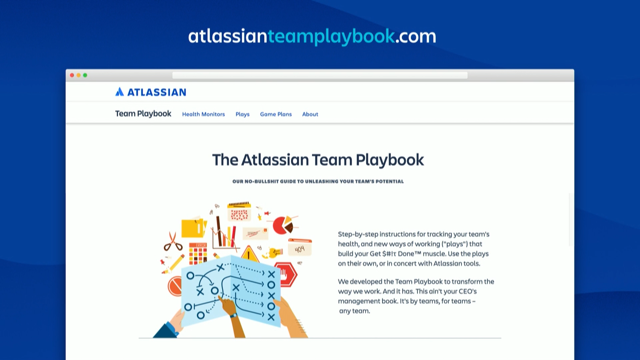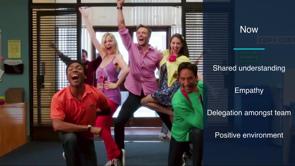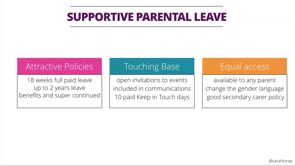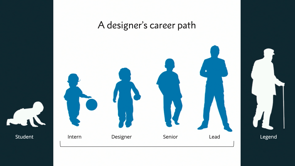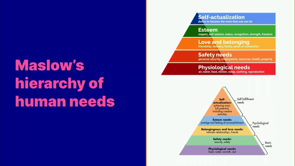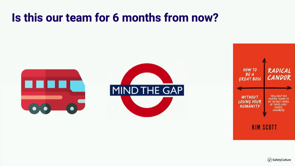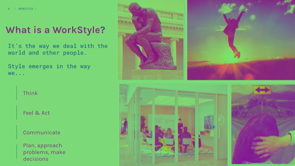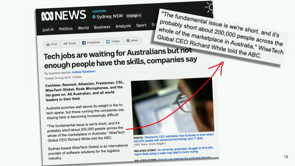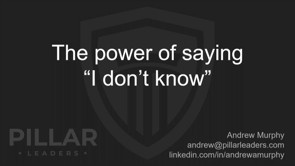
(upbeat music) - Just for show of hands I just wanna get a sense for who's in the audience, who might actually say that they're within a human resources or people and culture or learning and development function.
Okay, like a quarter of the room.
And who would actually classify yourself as a lead or a manager of a team? Yeah, okay.
And any individual contributors or practitioners? Awesome, cool, they do show up to Culture Conference.
Awesome stuff.
So the focus of this talk is really about three experiments for all of you guys here in this audience today to try today, tomorrow, and into this next week to build more effective cultures.
Before jumping in I actually just wanna talk about the two questions that I get most often since moving to Australia a few years ago.
The first question I get all the time is where are you from? I don't sound Australian, I don't have an Australian accent so get this question all the time whether it's meeting new colleagues or friends of friends or even if I'm shopping in a furniture store, I'll get this question, so where are you from? And I get really excited when I get this question because the answer is incredible.
I'm from this amazing, and magical, and culturally rich place called Dallas, Texas. Home of the assassination of John F. Kennedy in 1963, home of the Texas State Fair where you can see the biggest, most impressive livestock and eat the most delicious fried foods.
Home of the Dallas Cowboys and home to everyone's favourite Texas ranger, Walker Texas Ranger, Chuck Norris. And usually at that point when I'm answering the question, I usually sense a little bit of confusion in the other person's face.
They look at me and kind of like tilt their head. And they'll ask, "Okay, but where are you really from?" And has anyone actually gotten this type of question? It's a weird follow up question to get but I get it all the time, where are you really from? It's a confusing question for me because I'm really from Dallas, Texas, I was born and raised in Dallas, Texas.
So I'm like, maybe this is like an existential question that they're asking.
But where I'm really from and what I think the person is trying to ask is what is my cultural background? What is my ethnic background? And what are you all about? And my parents are really from Seoul, South Korea, they immigrated from Seoul to Brooklyn, New York in 1975, seeking the American dream and trying to create a better life for their future kids.
So this is me at the age of one, dressed up in traditional Korean clothing and growing up as one of the only Korean-American kids in Texas, even though it's an amazing place, I felt as uncomfortable as I look in that photo. And pointing that out, at the age of six, in the first grade, growing up as really the only Korean kid in my class and I was a really shrimpy kid, it was challenging.
Because at a very early age I was confronted by classmates who would introduce me to all these new words that I've never heard before, all these new words to describe the shape of my eyes, the colour of my skin and where, I guess, I'm really from. And you actually see in this year book I've circled myself and then I've circled the two other people within my class who accepted me for who I was and they were my friends.
And then I've crossed out Roy Lee Goley over here and he was one of the bullies that really confronted me with that colourful language and all those words to describe where I'm really from.
And growing up in Texas as one of the only Korean kids made me feel like a real outsider, made me feel like I didn't belong.
But then playing that out as I grew up within that environment it actually gave me a pretty powerful learning that being an outsider actually helps you to embrace other people's differences and find ways to actually bring them closer together.
The second question I get all the time is what's up with that blue hat? I don't think it's normal for Australians to wear blue hats so I get this question all the time because if you know me, I wear this blue about 10 to 12 hours a day. I wear it in boardrooms with our client organisations, I wear it giving talks, on panels, I even wear it at the Wiggles concert with my kids. So even on the weekends.
And for me the blue hat comes from one my biggest heroes growing up, Jackie Robinson.
I know most Australians don't know baseball but baseball's pretty much like cricket except it's maybe even more boring but a shorter timeframe.
And Jackie Robinson is famous for breaking the colour barrier in baseball in the '40s.
Before Jackie Robinson broke the colour barrier, the leagues were completely segregated, you had white leagues and then you had black leagues and none of the players actually played together. And Jackie was the first person to say, "You know what, I'm actually going to do the impossible, "I'm going to do the thing that no one thinks "that I can actually do." And in breaking the colour barrier, he was subjected to a lot of death threats, a lot of racist like language, not just from other people and other fans, but his manager and also his other team members. People on his own team actually confronted him like that. And what I love about that is even within that experience, Jackie had this amazing perspective that life is not important except in the impact it has on other lives.
So he was still able really focus on his purpose, which is to impact other lives more positively. And so the blue hat for me is a daily reminder whether it's in a business context or a personal context to be brave enough to break down barriers, to try to do the impossible and to positively impact the lives of others.
So when we take the answers of those two questions together, where are you from and also what's up with the blue hat, you get my career purpose.
The reason why I do my life's work and the thing that I try to do every single day, which is to build teams that embrace people's differences and to help them reach their full potential. I'm lucky enough to be able to do that at a place called Mentally Friendly, we're a design and innovation studio located in Redfern, we're about 40 people.
And our vision is to create wellbeing outcomes by designing products and services that change lives and reshape organisations. We do that essentially within the organisational design context by bringing leaders and teams together, essentially just helping them identify what's holding them back from doing their best work and getting them to try new things together. As an American I'm really good at getting people to try new things.
We do that with a lot of different types of organisations whether it's on the tech side or whether it's on the public service side, the media side, sometimes even startups of seven people within WeWork.
So we get a lot of different types of organisational problems that we see and a lot of different contexts that we get to work in.
So today's goal, the goal of this talk is really to inspire all of you to try three new things here, in this room, that you can take with you for the week.
Now we've talk a lot about, a really great theory around organisational change and building great cultures but what are things that you can practically do? The first thing I wanted to acknowledge and this is specifically for the people and culture people within the room, but I think it's also applies to managers and leads. What we hear is that being a culture leader today is really really hard, it's a really challenging, ever changing, complex environment.
And the things that we hear that really support this idea of just how challenging it is to be a culture builder today, number one, is your CEO, your managing director, your founders are probably putting pressure on you as a people and culture person to help the organisation be more responsive, more adaptive to continuous change, right? We know that now that culture is cool and a culture eats strategy for breakfast.
The c-suite actually really cares about what cultures we're actually building.
And they're looking to people and culture and managers and leads to be able to do that and to actually create the change that the organisation needs.
One of the clients we work with actually talks about this a lot.
The things that keep him most at night are thinking about the existential threats, the things that if those things play out would truly disrupt them and actually cease their ability to exist, a scary thought.
And he thinks that those threats are essentially three to five years away.
So if we do not adapt to the continuously changing environment then we will no longer exist, that's a lot of pressure. The second thing we hear is a lot of times from people and culture teams or HR is this idea of how can we actually increase buy in and engagement for our people strategy initiatives across the organisation? How do we build confidence in what we can do? How we do we build credibility? And what services or what initiatives we can actually implement within our organisation? And there's a lot even within a large tech company that we work with, very progressive culture, a very progressive leadership, even then, in speaking to their head of people, she's still actually really challenged by creating a strong relationship and that sense of trust from the founders.
The founders are still questioning what value can you actually deliver to our organisation? How can you actually help our business? Culture's over there for us, it's needs to be closer to the way we actually deliver value.
And the third thing, the thing that brings everyone to a culture conference is the strong desire and the strong purpose to create some kind of impact for the teams who are actually on the ground. So whether you're a manager, whether you're a P&C lead or a HR person, this is likely the reason why we're all here together, is to be able to do this more effectively.
The reason why we get pressures from the c-suite, the reason why it's so challenging to get buy in and also to realise and make real the impact to the teams on the ground, is because of the strategy action gap.
So if you think about all the work that you do as an organisation existing on this continuum from strategy on one side, to action on the other, strategy is all the types of things that you do like setting vision, setting corporate strategy, planning days, setting road maps, all those things that typically go into the realm of leadership and management. And then on the other side is the action, this is where the teams are actually delivering whatever product or service your company does or creates to actual customers or the audience or users, however you think about them.
Those are the people who are on the ground actually doing the work, writing code, writing copy, creating content, whatever it is that you guys do.
But all of the work that all organisations do exists on that type of continuum.
And the pool of scale and the pool of hierarchy really has created this strategy action gap, the separation from those who are setting strategy and leading strategy and creating strategy to those who have to implement and do the strategy. And I think that's equally as true for people in culture teams as organisations grow, as they start scaling and growing beyond a certain type of tipping point, they get to a place where it's like, well you know what? We've loved having this very organic sense of culture, just like come up naturally, we now need to dedicate a separate function to just focus on supporting our people and building a more effective culture, which, if you're listening to the c-suite, that actually is a type of strategy function. Culture and strategy actually work hand in hand together which is separate from where the teams are actually doing the work, which is closer to the action.
On the edges is where you get really sad people. If you're constantly just setting vision, resetting strategy, but not actually seeing the impact of the work that you do, that's really demotivating and likewise if you're just doing action, just task, but no connection back to the larger purpose or strategy that you're trying to accomplish, that's also very demotivating.
So how do we close this gap especially for people who are culture builders whether it's P&C people, or HR people, or managers and leads? How do we actually bring teams closer together and build more adaptive organisations and deliver more value to the teams on the ground? So I'm gonna run through three experiments here in this room.
The good news is that everything that you need to run these experiments is actually on your table. So if you look on your table you should see a stack of blue cards and then you've got these amazing ICC free pens that everyone should have.
If you grab a pen or if you're lucky enough to have a marker grab that and then grab a nice healthy stack of cards. Cool.
If you need more cards just raise your hand. Cool.
All right, let's jump into the experiments. First experiment.
So I want you to you take three cards and take about a minute to write down the first things that come to mind when you think about the three biggest barriers that are preventing your teams from doing their best work. If you're a manager these are your direct reports. If you're a P&C team, try to think about the teams actually on the ground that are closer to the action. So I'm not talking about your P&C teams, but the teams that are actually on the front lines. I want you to try to write down the three biggest barriers preventing your teams from doing their best work. Okay.
So everyone should have maybe a couple of their biggest barriers that they think that their teams are facing from doing their best work. With this experiment, the principle is this, we can't create change unless we actually bring teams closer in and really seek to understand.
There are a lot of things that we think exists within our organisations like problems that exist for our teams but if we're not actually seeking to understand them, and go deeper into them then we'll never be able to identify ways to actually solve them and actually be able to overcome those barriers.
One example of this, I work with a lot of organisations, one of the biggest organisations that we work with had recently conducted a survey with their teams and so within this EOS survey, they looked at all the feedback and one of the biggest points of feedback, one of the biggest themes was I don't think, from the teams as they're saying, I don't feel like I'm equipped to do my best work. All right.
And so the P&C team, reading these survey results have said, "Okay, well if they don't feel equipped "to do their best work, "then that must mean that it's a learning problem. "And if it's a learning problem "we should actually implement a LMS, "LMSs solve learning, right?" So they starting going down this road of issuing an RFP, trying to actually implement a multi-million dollar LMS system, simultaneously also trying to implement training to up skill their teams because they thought that their teams weren't equipped with the skills to do their best work.
And then we started to actually, having conversations with this company, actually starting to talk to their teams and diagnose, trying to get to the root cause of why the teams actually felt that way.
It turns out that it wasn't learning, learning wasn't actually the problem, it was actually a leadership problem.
The teams didn't feel equipped because they didn't understand the strategy or the priority or the vision of the company. They had no connection back to what the company was even trying to do and how their work on a day to day basis even fit in.
So what P&C thought was a learning problem was actually a leadership problem.
So with that card you've got the three biggest barriers, what I want you to do over this next week is actually keep those front and centre, like put them up on your monitor or put them up on your bathroom mirror, tape them up.
And make it your mission to try to understand those barriers, don't just take them at surface level, try to continuously ask why are these things happening with our teams? Why are teams facing this? And what is the result? The second experiment, so looking at those three barriers that you have on those three cards, I want you to write down the names of the people on the ground who are most impacted by those barrier the most.
Specific people within your organisation who are impacted by these things the most.
If it's a lot of different barriers then you can focus on one at a time and just say, "Cool, for this barrier I think it's Katie "and Jen and John." I'll give you a tip, it's most likely not your senior leadership, right.
Your senior leadership don't face these problems day to day, they don't encounter those barriers day to day, so try to think about the actual people on the ground.
I'll give you guys a minute.
Awesome.
Well hopefully you have a nice group of people on your card.
And the second principle attached to this experiment is to approach your teams with a beginner's mindset. That first starts by identifying who those people within those teams actually are and being able to actually try to pull them in. The reality is that for those barriers that you wrote down and these people, no one is a bigger expert of those problems than your teams.
Fundamentally we see a lot of teams and organisations use surveys to try to get a sense for what's actually happening within the organisation.
It's quick, you can make it anonymous, and get a lot of feedback very quickly.
But time and time again we see organisations get crippled with the amount of data and information that comes back from the surveys.
Almost never do we hear, "Oh we got some survey data and we know exactly "what we need to do with it." Often times it's like, we made this printout, we started reading it, we have no idea what we can actually do to action some of these problems.
So while surveys might be a good way to sense check what's happening within your organisation, a nice way to measure your organisation on a few of the key metrics that matter most to your company, over time, you will never be able to truly understand your teams, the work that they do and the things that are preventing them from doing their best work by just looking at the survey.
It actually requires pulling those people in closer to actually understand what's actually happening on the ground.
So the second experiment is to, with those people on your card, try to just reach out, whether it's through Slack or sent them an invite, ask them out for a coffee, and just set up a 35, 45 minute chat and actually run that first exercise with them. Give them some cards and say, "I'm running an experiment here, "I just wanna understand what's actually happening "on the ground with you guys as a team.
"What are the biggest barriers holding you guys back "from doing your best work?" And instead of pulling your cards and saying, "Well hey, here's what I think, "let me tell you my perspective," just listen. Approach it as if you know nothing, a true beginner's mindset.
Because approaching it by actually knowing nothing will help you identify not just what the root causes of those problems are and better understand the nuance of those problems, but identify opportunities that you may have not been able to identify previously. That's the mission for this week, set up a time to sit down with your teams and ask them what's holding them back from doing their best work.
Third experiment, okay so with your remaining cards, whether it's like two or three cards, I'll give you a minute to write down what are the most important initiatives for you this year and why? So if you're a people and culture or HR team, that's pretty easy, it's like these are my top three initiatives. If you're a team lead or manager, think about the work streams within your team that are really important.
If you're an individual contributor then you can think about what my leads actually say are the most important things.
If you don't know then just draw a question mark. I'll give you a minute to write those things down. Okay for the sake of time, I'm gonna call it. I don't know what just happened.
Sorry.
It just went out.
So with those cards the experiment is actually to with those same groups of people, the people that you're setting this meeting up with is actually share those cards out to those teams to explain to them, from your perspective, what you think is important.
Give them a sense of priority and say, "Hey these are the three things that I think "for this next year are the most important things "that we do really well." Explain why.
And then what I'm gonna ask you to do is actually to say, "Okay team, from your perspective, "what do you think is gonna create the most impact? "What do you think is going to "actually going to address the barriers "that you guys just shared? "What are the things that you think "are gonna deliver the most value?" I'll try to just fix that here.
Okay.
So the third principle, you don't see it up here is to build trust by being open to change.
We know that building adaptive cultures and actually delivering impact to teams on the ground can't be done by just one person alone or one team alone.
You're not gonna create cultural change just from P&C working in a silo, it takes real collaboration.
When we talk about collaboration, it's not just about working with other people, it's actually about your ability to change your mind, to change your perspective based on new information or new perspectives that other people are offering up. So with that experiment and actually asking the teams to reprioritize, hey what do you think is actually going to deliver value? And allow yourself to listen to that feedback from your teams and reprioritize what you think matters for the year.
And if something doesn't feel like it's actually gonna deliver value maybe it's a chance to actually kill it or adapt it. Yeah, cool.
What's powerful about framing these things as experiments, everyone within this room just did three small experiments and ideally a lot of you guys can take those cards with you, set up time with your team and actually go through a similar exercise yourself.
What's powerful about experiments is that experiments give you permission not to try something new, but it sets an expectation that you need to learn something about it.
So I'm going to try something then what I need to do is actually reflect back on what I've learned, what worked well, what didn't work well? And the ideal is to create a learning loop. The things that you can try, things that you can learn, and things that you can do on a daily basis, that you can incorporate into your day to day. So just recapping, three things to try to building more adaptive cultures and helping to create a bigger impact to the teams on the ground.
Is number one, bring teams closer by seeking to understand.
Number two, approaching teams with a beginner's mindset and number three, is building trust by being open to change.
Cool, thank you so much guys.
(audience applause) (upbeat music)
